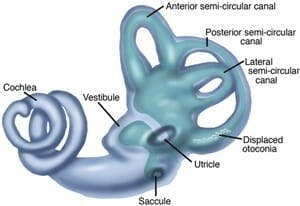
BPPV or Benign Paroxysmal Positional Vertigo is a dysfunction in the vestibular system located in the inner ear. BPPV is characterized by brief periods of spinning or dizziness when changing positions. The positions that most likely trigger feelings of dizziness are looking up, lying on a flat surface, or turning on your side.
BPPV affects the semicircular canals located in the inner ear. Feelings of dizziness occur when crystals or otoconia break off and move into the semicircular canals. In a normal inner ear the semicircular canals do not have any crystals. These crystals are found in another part of the inner ear called the utricle. When conditions arise such as infection, virus, head trauma, or aging crystals my break off of the utricle and land in the semicircular canals. When this occurs a person may experience short bouts of spinning or dizziness.
In a dysfunctional inner ear the crystals sometimes called ear rocks will be free floating in the canals. When the head is moved into a specific position it causes the crystals to move through the canals. This movement of the crystals through the semicircular canals cause nerve endings in the inner ear to become stimulated that results in a dizzy/ spinning sensation. These positions are specific to the orientation of the canals and are extremely predictable. It is typical for individuals with BPPV to decrease the frequency of symptoms by avoiding these predictable positions.
Some people may just try to avoid positions that make them dizzy but you will be happy to know that BPPV is easily treatable through physical therapy techniques called Canalith Repositioning Maneuvers.
Canalith Repositioning maneuvers move the crystals back into the utricle where they belong causing symptoms of dizziness to resolve.
5 FREQUENTLY ASKED QUESTIONS ABOUT BPPV

- How long do bouts of dizziness last?
The dizzy sensation that people feel is called vertigo. In BPPV, when the head is moved into a specific position dizziness will last a few seconds and usually no longer than 30 seconds. - What does Vertigo feel like?
When a person experiences vertigo they typically feel like the room is spinning. But often people will not feel the spinning sensation. They will feel milder symptoms of lightheadedness, nausea, or imbalance. - How does someone know if his/her dizziness is caused by BPPV?
BPPV is diagnosed by a specialized vestibular therapist performing positional testing. During these positional tests the therapist looks at involuntary eye movements called nystagmus. Based on the direction of the nystagmus along with the specific position that provokes the symptoms the therapist can determine which canal the crystals are located. - How can a vestibular therapist help with BPPV?
Once the therapist determines which canal is involved from positional testing and observing the direction of the involuntary eye movements they can come up with a plan to treat the BPPV. Using canalith repositioning maneuvers which are series of head movements the therapist can help guide the crystals back into their correct location. Once the crystals are back in the utricle pts will not have positional dizziness any longer. - How many treatments does it take to treat BPPV?
BPPV is usually treated in less than 3 sessions of therapy. There is often a 90% reduction in symptoms following the first visit.
REAL LIFE EXPERIENCES
Laura B. is a 68-year-old woman with vertigo that began one morning 2 weeks ago when she got out of bed and the world started to spin. Since then, she’s been having vertigo, nausea, and problems with her balance. When she visits her physical therapist, he gives her a special questionnaire to find out exactly what brings on her dizziness and balance difficulty. Turning over in bed and bending over or looking up cause her the most severe symptoms.
The physical therapist reviews Laura’s medical history to make sure that there is no past condition that might be important to her problem. He performs an examination, explaining what tests he will use and that Laura should try to keep eyes open and stay in position. The tests show that in certain positions, Laura’s eyes move when they shouldn’t, and she has vertigo that lasts 5 seconds. The therapist determines that she has the “canalithiasis form” of vertigo, which means that some crystals are displaced and are located in her semicircular ear canals, causing her vertigo.
The therapist uses “canalith repositioning” to move the crystals into a proper position, using the Epley maneuver. Afterwards, he asks Laura to wait in the waiting room for a while. He then does a re-test. Laura no longer has the symptoms that she had when the therapist tested her the first time, so he shows her how to do the canalith repositioning maneuver at home. She is to do the maneuver once every day in the morning for one week and then will return to the clinic to make sure that she is progressing as expected.
